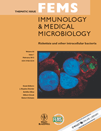Antibiotic susceptibility and intracellular localization of Diplorickettsia massiliensis
Abstract
Diplorickettsia massiliensis is an obligate intracellular bacterium from the Coxiellaceae family recently isolated from Ixodes ricinus ticks. The inhibitory effects of antimicrobial agents were assessed by two different methods, immunofluorescence and Gimenez staining assay. Different markers (EEA1, Lamp-1, Cathepsin D, and LysoTracker Red DND99) were used to reveal the nature of the vacuole containing the bacterium. Ciprofloxacin, levofloxacin, and rifampin had MIC values of 2 μg mL−1. We found that 4 μg mL−1 of Doxycycline inhibited the growth of D. massiliensis strain. Surprisingly, D. massiliensis was resistant to chloramphenicol up to the concentration of 64 μg mL−1. We found that penicillin G, ammonium chloride, gentamycin, omeprazole, bafilomycin A1, and chloroquine were not active against D. massiliensis. Studies performed with markers EEA1, Lamp-1, Cathepsin D, and LysoTracker Red DND99 showed that D. massiliensis is localized within an acidic compartment that is not an early phagosome, but a late phagosome or a phagolysosome. Gimenez staining stays a good method that will work with a very low number of bacteria and can be used to determine the MICs of new therapeutic antibiotics precisely. The resistance profile of D. massiliensis was found to be quite unusual for intracellular Gram-negative bacterium with marked resistance to chloramphenicol. Despite of localization in acidic compartment, pH-neutralizing agents do not significantly inhibit intracellular growth of bacterium. The results of these studies prove that antibiotic resistance does not depend on pH of vacuole. This pH-related mechanism seems not to play a contributing role in the overall resistance of D. massiliensis.




